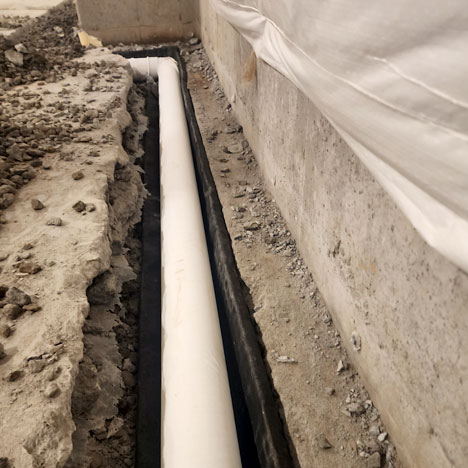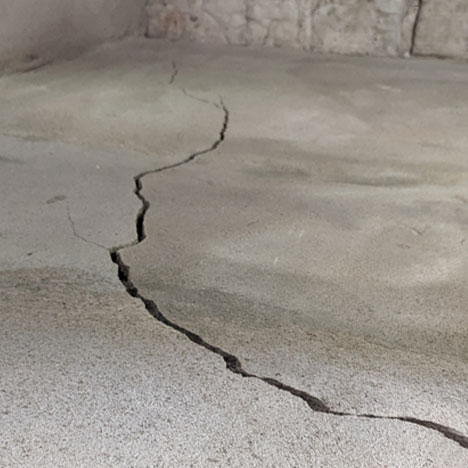Protect Your Foundation from Cracks and Water Seepage
When it comes to keeping your basement dry, few problems are as destructive, or as misunderstood, as hydrostatic pressure. Even the strongest foundation can fall victim to the relentless force of groundwater pushing against basement walls and floors. Over time, this pressure can cause cracks, leaks, and structural instability. That’s where a hydrostatic pressure relief system comes in. This innovative waterproofing solution helps equalize pressure, redirect water away from your foundation, and protect your home from costly water damage.
Contact Us Today by filling out the form below, or calling us at 1-610-241-7009
What Is Hydrostatic Pressure?
Hydrostatic pressure refers to the force exerted by standing water in the soil surrounding your foundation. When the ground becomes saturated, after heavy rainfall, melting snow, or poor surface drainage, the water pressure builds up and pushes against the concrete walls and floor of your basement. Concrete is porous by nature, so even small amounts of water pressure can lead to seepage through hairline cracks or joints.
Common Hydrostatic Pressure Causes:
- Wall cracks and bowing
- Water seepage at the floor-wall joint
- Efflorescence (white mineral deposits) on walls
- Dampness or mold growth
- Flooding during heavy rain

How a Hydrostatic Pressure Relief System Works
A hydrostatic pressure relief system, sometimes referred to as a drain tile system or interior drain system, is designed to capture and redirect groundwater before it causes damage. The result is a dry, stable basement where groundwater pressure no longer threatens your foundation. The system typically includes the following components:
- Perforated Drainpipe: Installed along the perimeter of the basement floor, this pipe collects groundwater that seeps under or around the foundation.
- Gravel Bed or Channel: The drainpipe sits in a gravel trench or drainage channel that allows water to flow freely toward the sump pit.
- Sump Pit and Sump Pump: Collected water is directed to a sump pit, where a sump pump automatically removes it from the basement and discharges it safely outside, away from your foundation.
- Drainage Board or Wall Membrane (Optional): Some systems include a wall vapor barrier or drainage mat that guides any wall seepage directly into the perimeter drain system.

Signs You May Need to Install a Hydrostatic Pressure Relief System
If left untreated, hydrostatic pressure can compromise your foundation’s integrity and significantly impact indoor air quality due to moisture and mold. If you’re not sure whether your home needs this type of waterproofing system, look for these warning signs of hydrostatic pressure:
- Persistent basement dampness or musty odors
- Water seepage where walls meet the floor
- Efflorescence or discoloration on basement walls
- Cracks that widen after heavy rain
- Bowing or leaning foundation walls
- Sump pump that runs frequently or can’t keep up with water inflow
Financing Offers Available
Hearth Financing Offers 0% Financing, Monthly Payment Options, And A 60 Second Pre-Qualification That Doesn’t Affect Your Credit Score. Start Your Application Today.
Why Choose to Install a Hydrostatic Pressure Relief System
Many homeowners attempt to manage basement leaks with quick fixes like waterproof paint or patching cracks, but these solutions only mask the symptoms. The real issue, hydrostatic pressure, remains unchecked.
A hydrostatic pressure relief system tackles the problem at its source by relieving the pressure and channeling water away from your foundation. This system not only prevents leaks but also helps preserve your home’s structural stability.
Key Benefits of System Installation
The benefits of a hydrostatic pressure relief system are significant. It provides long-term water control by creating a path for water to escape, reducing buildup and preventing future leaks. It also protects your foundation by minimizing cracking, bowing, and deterioration of foundation walls. A drier basement environment helps prevent the growth of mold and mildew, improving overall indoor air quality. Homes with a reliable waterproofing system are more attractive to buyers and tend to maintain better long-term value. Ultimately, having this system in place gives you peace of mind, knowing your basement is protected from one of the most common causes of foundation failure.
Call 1-610-241-7009 For Your Free Consultation Today
The Hydrostatic Pressure Relief Installation Process
Installing a hydrostatic pressure relief system is a specialized process that should be handled by an experienced waterproofing contractor, like our pros at AWS. The process begins with a thorough assessment and planning phase, during which the contractor evaluates your basement’s layout, the extent of the water issue, and existing drainage conditions to determine the best placement for the drainage channels and sump pit. Once the plan is set, a narrow strip of the basement floor, typically 12 to 18 inches wide, is cut and excavated around the interior perimeter down to the footing level to expose the joint where the wall meets the floor. A perforated PVC drainpipe is then installed in the trench and surrounded with clean gravel to create a channel that directs water toward the sump pit. The drain line is connected to the sump pit, where a sump pump is installed to discharge collected water safely outside the home. After the system components are securely in place and tested, the trench is re-cemented, leaving only the sump pit exposed for maintenance. The contractor will then test the system to ensure proper operation of the sump pump and verify that water is draining efficiently before cleaning and restoring the work area.
Maintenance for Your Waterproofing System is Important
While hydrostatic pressure relief systems are highly effective, they do require occasional maintenance to remain in top condition. Homeowners should test their sump pump at least twice a year, typically before the rainy season and again before winter, to ensure it’s working properly. It’s also wise to consider adding a battery backup for the sump pump to prevent flooding during power outages. The sump pump discharge line should be inspected regularly to ensure it’s free from obstructions and directing water away from the foundation. Periodic professional inspections can help identify any sediment buildup or system blockages before they cause issues. With proper care, a hydrostatic pressure relief system can last for decades, keeping your basement dry and your home structurally sound.
Contact AWS for Expert Basement Waterproofing Solutions
If you’re dealing with basement water problems or suspect hydrostatic pressure is affecting your foundation, don’t wait for the damage to get worse. AWS specializes in hydrostatic pressure relief system installation and other comprehensive waterproofing solutions designed to keep your basement dry year-round. Our team of home waterproofing experts can assess your property, identify the source of the issue, and install a long-lasting system tailored to your property’s needs. Contact AWS today to schedule a consultation and take the first step toward a dry, healthy, and structurally sound basement.

